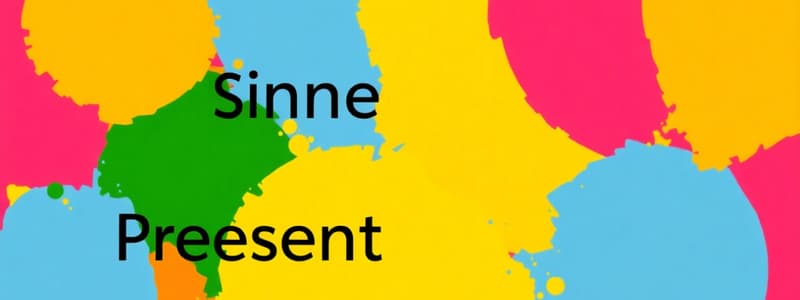Podcast
Questions and Answers
Consider the sentence: 'He is always borrowing my books and not returning them.' What does the use of the present continuous with 'always' suggest in this context?
Consider the sentence: 'He is always borrowing my books and not returning them.' What does the use of the present continuous with 'always' suggest in this context?
- It indicates a scheduled future event.
- It describes a general truth about his borrowing habits.
- It emphasizes the temporary nature of his borrowing.
- It expresses annoyance or disapproval about his repetitive action. (correct)
Which sentence demonstrates the correct usage of a stative verb in present continuous to describe an action, rather than a state?
Which sentence demonstrates the correct usage of a stative verb in present continuous to describe an action, rather than a state?
- She is loving the new car.
- He is seeing his therapist tomorrow. (correct)
- They are knowing the answer to the question.
- I am needing a vacation.
Which of the following sentences correctly uses a time expression that implies the action is happening around the present time, making the present continuous tense appropriate?
Which of the following sentences correctly uses a time expression that implies the action is happening around the present time, making the present continuous tense appropriate?
- She is studying for her exams these days. (correct)
- They visit their grandparents every weekend.
- He always drinks coffee with breakfast.
- I usually go to the gym every morning.
Which option correctly identifies the subtle difference in meaning when using the present simple versus the present continuous form of the verb 'to taste'?
Which option correctly identifies the subtle difference in meaning when using the present simple versus the present continuous form of the verb 'to taste'?
How does the use of present simple in conditional sentences (Type 0) differ from its use in conditional sentences (Type 1)?
How does the use of present simple in conditional sentences (Type 0) differ from its use in conditional sentences (Type 1)?
Which sentence uses the present continuous to describe a changing or developing situation rather than an action happening at the moment of speaking?
Which sentence uses the present continuous to describe a changing or developing situation rather than an action happening at the moment of speaking?
Analyze the following sentences and determine which one exploits the present simple to describe a scheduled event functioning almost as a future arrangement.
Analyze the following sentences and determine which one exploits the present simple to describe a scheduled event functioning almost as a future arrangement.
Select the sentence where a stative verb is appropriately used in the present continuous to highlight a deliberate action, contrasting with its typical descriptive state.
Select the sentence where a stative verb is appropriately used in the present continuous to highlight a deliberate action, contrasting with its typical descriptive state.
Examine the time expressions in the provided sentences and identify which one is used correctly with the Present Continuous to indicate an action that is happening temporarily around the present time.
Examine the time expressions in the provided sentences and identify which one is used correctly with the Present Continuous to indicate an action that is happening temporarily around the present time.
Evaluate the use of time expressions to distinguish between habit and current action, and select the sentence that accurately uses a time expression with the present continuous to describe what’s happening now.
Evaluate the use of time expressions to distinguish between habit and current action, and select the sentence that accurately uses a time expression with the present continuous to describe what’s happening now.
Flashcards
Present Simple Use
Present Simple Use
Used for habits, routines, general truths, and permanent situations.
Present Simple Affirmative
Present Simple Affirmative
Base form of the verb, or base form + -s/-es (for he, she, it).
Present Simple Negative
Present Simple Negative
do/does + not + base form of the verb.
Present Simple Questions
Present Simple Questions
Signup and view all the flashcards
Present Continuous Use
Present Continuous Use
Signup and view all the flashcards
Present Continuous Affirmative
Present Continuous Affirmative
Signup and view all the flashcards
Present Continuous Negative
Present Continuous Negative
Signup and view all the flashcards
Present Continuous Questions
Present Continuous Questions
Signup and view all the flashcards
Stative Verbs
Stative Verbs
Signup and view all the flashcards
Time Expressions
Time Expressions
Signup and view all the flashcards
Study Notes
- The present simple and present continuous are two distinct verb tenses in English, each with specific usage rules, forms, and time expressions.
Present Simple
- The present simple is used to describe habits, routines, general truths, and permanent situations.
- It indicates actions that occur regularly or states that generally exist.
- Affirmative form: base form of the verb (for most subjects), or base form + -s/-es (for third-person singular subjects: he, she, it).
- Negative form: do/does + not + base form of the verb.
- Question form: Do/Does + subject + base form of the verb?
- Time expressions commonly used with the present simple include: always, usually, often, sometimes, rarely, never, every day/week/month/year, on Mondays/Tuesdays, etc., in general, as a rule.
- Example affirmative: I play tennis every week.
- Example negative: He does not (doesn't) like coffee.
- Example question: Do you speak Spanish?
Usage Rules for Present Simple
- Use to describe habits and routines: e.g., "I wake up at 7 a.m. every day."
- Use to state general truths and facts: e.g., "The sun rises in the east."
- Use to describe permanent situations or states: e.g., "She lives in London."
- Use to express schedules and timetables: e.g., "The train leaves at 10 a.m."
- Use for giving instructions or directions: e.g., "You turn left at the next corner."
- Use in time clauses and conditional sentences (Type 0 and Type 1): e.g., "If you heat water, it boils." / "If it rains, I will stay home."
Present Continuous
- The present continuous is used to describe actions happening at the moment of speaking, temporary situations, and future arrangements.
- It emphasizes that an action is in progress or is not yet completed.
- Affirmative form: am/is/are + present participle (base form of the verb + -ing).
- Negative form: am/is/are + not + present participle.
- Question form: Am/Is/Are + subject + present participle?
- Time expressions commonly used with the present continuous include: now, right now, at the moment, these days, currently, today, tonight, this week/month/year, still.
- Example affirmative: I am studying English now.
- Example negative: They are not (aren't) watching TV.
- Example question: Are you listening to me?
Usage Rules for Present Continuous
- Use to describe actions happening at the moment of speaking: e.g., "I am talking on the phone."
- Use to describe temporary situations: e.g., "She is staying in a hotel for a week."
- Use to describe changing or developing situations: e.g., "The climate is changing rapidly."
- Use to describe future arrangements: e.g., "We are meeting for dinner tonight."
- Use with "always," "constantly," or "continually" to describe annoying habits: e.g., "He is always complaining."
Stative Verbs
- Stative verbs describe states, thoughts, feelings, senses, or possession rather than actions and are generally not used in the present continuous.
- Common stative verbs include: be, have, know, understand, believe, remember, love, hate, see, hear, smell, taste, want, need, seem, appear.
- Example incorrect: I am knowing the answer.
- Example correct: I know the answer.
- Some stative verbs can be used in the continuous form when they describe an action rather than a state.
- Example: "I am seeing the doctor tomorrow" (arrangement) vs. "I see what you mean" (understanding).
- Example: "She is tasting the soup" (action) vs. "The soup tastes delicious" (state).
Time Expressions
- Time expressions are important for indicating when an action takes place, thus helping to determine the correct tense.
- For the present simple, expressions like "every day," "usually," and "never" indicate regular or habitual actions.
- Example: "I usually drink coffee in the morning."
- For the present continuous, expressions like "now," "at the moment," and "these days" indicate actions happening around the present time.
- Example: "I am working from home these days."
- Context and specific verbs can influence the choice of time expressions.
- Example: "The sun rises in the east" uses the present simple to state a general truth without a specific time expression.
- Example: "They are getting married next month" uses the present continuous to describe a planned future event.
Summary of Key Differences
- The present simple describes what happens regularly or is generally true, while the present continuous describes what is happening now or is temporary.
- The present simple uses the base form of the verb (or -s/-es for third-person singular), while the present continuous uses "am/is/are" + present participle (-ing).
- The choice between the two tenses often depends on whether the action is habitual/general or in progress/temporary.
- Understanding the nuances of stative verbs is crucial for correctly using the present continuous.
- Correct use of time expressions provides essential context for determining the appropriate tense.
Studying That Suits You
Use AI to generate personalized quizzes and flashcards to suit your learning preferences.



